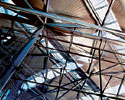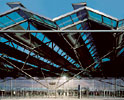Flights of Fancy in Long-Span Design
The new terminal consists of a large, curved section that the designers refer to as the "high-roof" area of the central processor, a lower and narrower zone called the "liner area" of the central processor, and several piers that extend perpendicularly from the liner area. Each pier ends in a large waiting area known in aviation parlance as a "hammerhead." The groundside of the terminal faces north; airside is south. Once completed, the central processor will measure roughly 1,000 feet from end to end.
As its name implies, the high-roof area features an arched roof that spans about 230 feet over the departure hall. "The design direction from the client-including unobstructed views of the airport and to the airfield-made long-span the logical choice," explains Ettelman. The developer wanted the building to be "intuitive" to the passengers, with abundant visual connection.
The arch construction allows the roof to span a longer space than would have been possible if the girders were flat. To capitalize on this "arch action," explains Mike Meschino, senior associate of Halcrow Yolles, the designers had to achieve a height-to-span ratio of at least 1:8. The final design came in only slightly above this minimum requirement, at about 1:9. "The architects wanted as flat a curve as possible while keeping a thin profile," recalls Meschino. He explains that, had they gone much flatter, they would have had to switch to a 20-foot-deep truss system. In contrast, the depth of the wide-flange plate girders that create the arches is only 55 inches.
Forty-three arches are positioned 2.25 degrees apart in a radial pattern. This translates into a distance of about 25 feet on center along the north wall and 33 feet on center along the south wall. Although they are structurally monolithic, the 217-foot girders had to be erected in two pieces and then connected, either by welding where the splice is exposed to view or bolted where it is hidden behind ceiling finishes.
The girders transfer their loads on both the north and south sides via pin connections. On the north side, each arch is supported by a frame consisting of two 100-foot-tall architecturally exposed structural-steel-tube columns braced with one diagonal and one horizontal tie, both fabricated from built-up plates. Horizontal wide-flange beams running perpendicular to the frames at floor level give lateral stability in this direction. Diagonal steel tubes within the concentric plane created by the outer row of columns provide additional bracing between the frames.
Cologne/Bonn Airport
By the early 1990s, the number of passengers coming through the lone terminal at Germany's Cologne/Bonn Airport had far exceeded its design capacity of 3 million per year. In response, the airport authority organized a design competition to start working on a second building that would greatly expand upon the first. Murphy/Jahn of Chicago was selected as the architect for the overall project, which-in addition to the new terminal-included an underground rail station, two parking garages, and a two-level roadway. Three structural engineering firms contributed to the terminal itself: The local firm of IGH handled the concrete work; Werner Sobek of Stuttgart, Germany, addressed the glass facade; and Arup's New York office was responsible for the long-span roof. The new facility was completed in 2000.
The first and second terminals are a study in contrasts. Terminal 1 was designed in the 1960s-before wide-body jets became commonplace and heightened concerns for security necessitated a greater degree of centralization, notes Steven Cook, AIA, principal architect at Murphy/Jahn. The older terminal is U-shaped and constructed of concrete. The new terminal is linear to better accommodate the larger aircraft and to establish maximum clarity for both departing and arriving passengers. Although supported by a concrete base, its upper levels sparkle with prefabricated steel and glass.
The 743,000-square-foot Terminal 2, which has increased the airport's total passenger capacity to 7.5 million per year, is organized vertically: A portion of the underground train station occupies the lowest two levels; the arrivals hall is located on level three; baggage handling, plus some retail and connections to parking, can be found on level four; and the departure hall sits on top at level 5.












